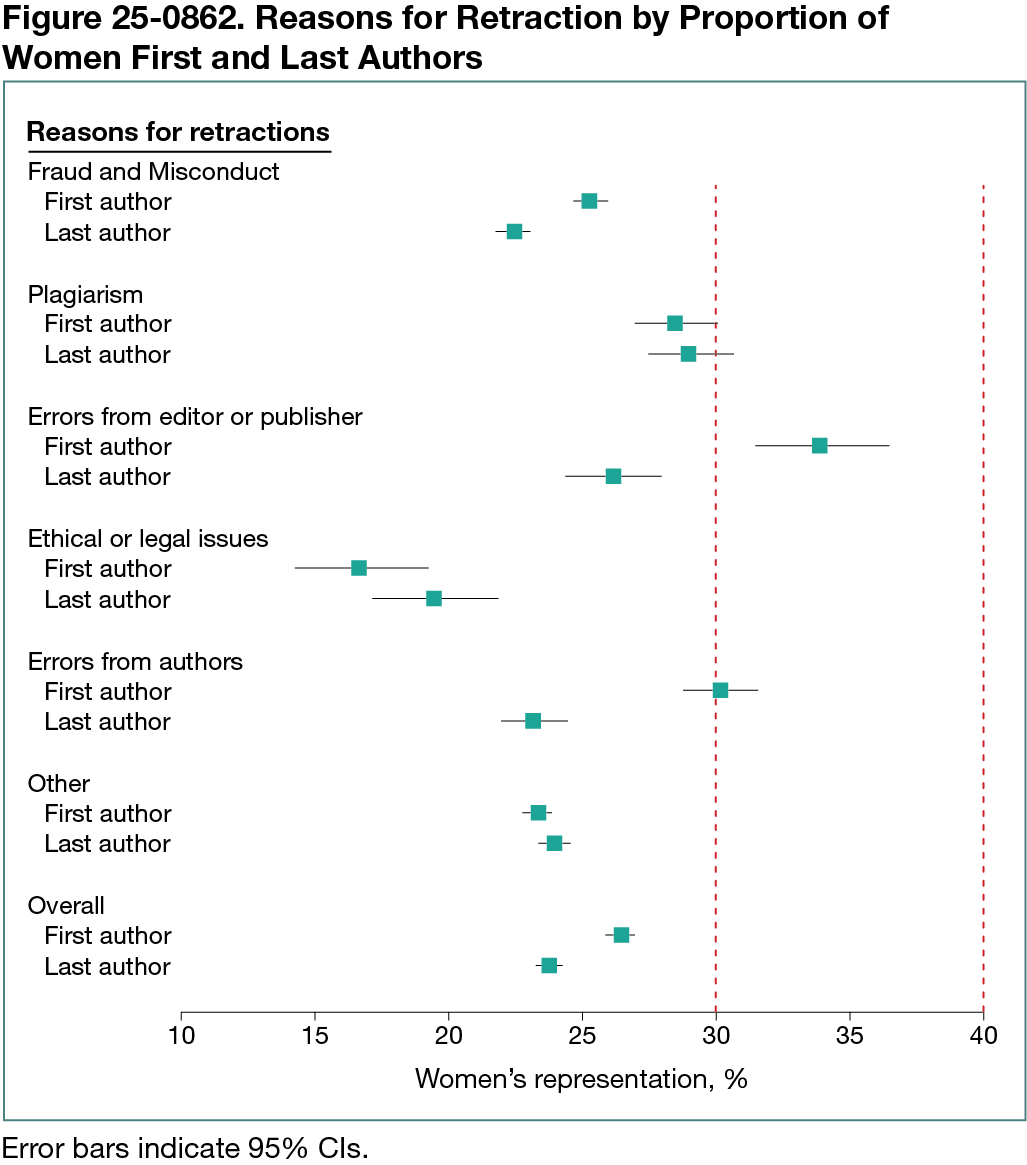Abstract
Comparison of Reasons for Retraction of Biomedical Articles by Women and Men Authors
Ana-Catarina Pinho-Gomes,1,2 Carinna Hockham,1 Mark Woodward1,3
Objective
Women are underrepresented among authors of scientific papers. Although the number of retractions has been rising over the past few decades,1 gender differences among authors of retracted papers remain poorly understood. Therefore, this study investigated gender differences in authorship of retracted articles available on RetractionWatch.
Design
RetractionWatch (http://retractiondatabase.org/) provided us a dataset comprising 64,658 articles published between January 1971 and June 2025. This is an update of a previous study.2 No articles were excluded. We extracted data for the first and last author of each paper and inferred their gender based on their first names using Gender-API software. We accepted gender predictions when the accuracy was estimated to be at least 80%. We estimated the percentage of retractions that could be attributed to women and men first authors and last authors overall and by reason. We used binomial distributions to estimate percentages retracted by women authors, with 95% CIs, and tested whether these percentages were significantly different from 50%. We compared women’s representation as authors of retractions vs their representation as authors of articles overall (40% for first authors and 30% for last authors3).
Results
Among 64,658 articles retracted between 1971 and 2025 that included 64,659 first authors and last authors, women accounted for 26.4% (95% CI, 25.8%-26.9%) of first authors and 23.7% (95% CI, 23.2%-24.2%) of last authors. There were significant differences in gender of authors in retracted articles by reason, and women’s representation appeared to be lower than their representation as authors of scientific articles (Figure 25-0862). The lowest representation of women was found for ethics and legal issues (16.6% [95% CI, 14.2%-19.2%] for first authors and 19.4% [95% CI, 17.1%-21.8%] for last authors). For first authors, women’s representation was the highest for errors caused by editors and publishers (33.8% [95% CI, 31.4%-36.4%]). For last authors, the highest representation of women was for plagiarism (28.9% [95% CI, 27.4%-30.6%]). Most retractions (60.9%) had men as first and last authors.
Conclusions
Women’s representation among authors of retracted articles seemed to be slightly lower than women’s representation as authors of scientific papers overall. Women’s underrepresentation as authors of retractions due to fraud and misconduct as well as ethical concerns suggests that gender equality might enhance research integrity and, hence, reduce the negative impact that retractions have on population health and trust in science.
References
1. Gaudino M, Robinson NB, Audisio K, et al. Trends and characteristics of retracted articles in the biomedical literature, 1971 to 2020. JAMA Intern Med. 2021;181(8):1118-1121. doi:10.1001/jamainternmed.2021.1807
2. Pinho-Gomes A-C, Hockham C, Woodward M. Women’s representation as authors of retracted papers in the biomedical sciences. PLoS ONE. 2023;18(5):e0284403. doi:10.1371/journal.pone.0284403
3. Squazzoni F, Bravo G, Farjam M, et al. Peer review and gender bias: a study on 145 scholarly journals. Science Advances. 2021;7(2):eabd0299. doi:10.1126/sciadv.abd0299
Affiliations
1The George Institute for Global Health, Imperial College London, London, UK, a.pinho-gomes@imperial.ac.uk; 2Institute for Global Health, University College London, London, UK; 3The George Institute for Global Health, University of New South Wales, Sydney, New South Wales, Australia.
Conflict of Interest Disclosures
Mark Woodward has been a consultant for Amgen and Freeline. No other disclosures were reported.
Funding/Support
Ana-Catarina Pinho-Gomes is funded by an Academic Clinical Lectureship by the National Institute for Health and Care Research (NIHR). Mark Woodward is supported by the National Health and Medical Research Council of Australia grant APP1174120.
Role of Funder/Sponsor
The funders had no influence in the design and conduct of the study; collection, management, analysis, and interpretation of the data; preparation, review, or approval of the abstract; and decision to submit the abstract for presentation.
Disclaimer
The views expressed are those of the authors and not necessarily those of the NIHR or the Department of Health and Social Care.

